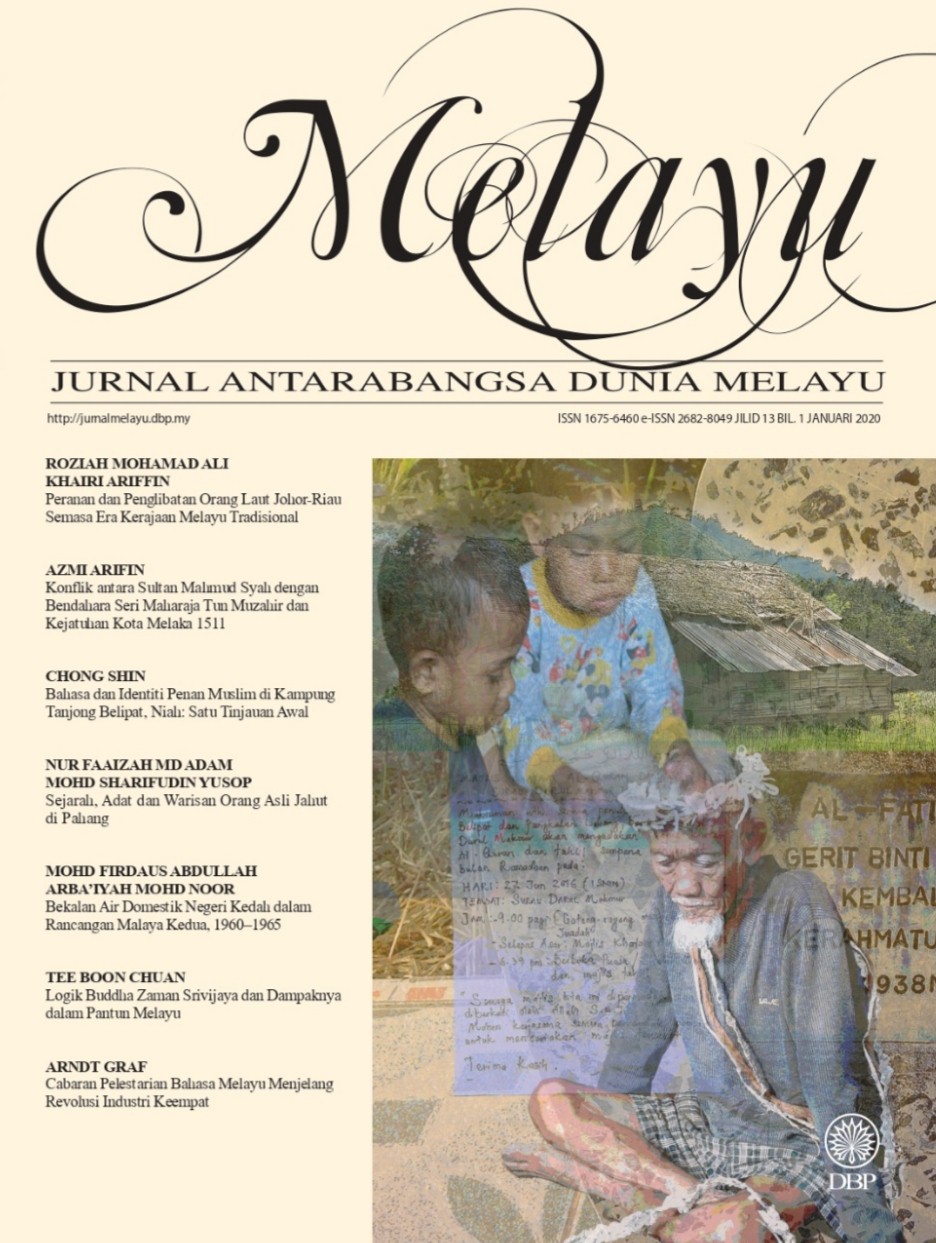Srivijayan Buddhist Logic and Its Impact on the Malay Pantun
(Logik Buddha Zaman Srivijaya dan Dampaknya dalam Pantun Melayu)
Abstract
This paper aims to trace the origin of Malay pantun to the Buddhist logic of Srivijaya at the end of 7th century. Theoretical evidence from the records of Yi Jing (or I-Tsing, 635 CE-713 CE) shows that both Buddhist and public societies in Srivijaya were familiar with the genre of gātha (गाथ), a genre of Buddhist reasoning of Dharmakīrti (fl. 600 CE-650 CE) consisting of four lines comprising two units: thesis and reasons. Evidence from Srivijaya-era texts, i.e. from the Hastadaņda Śāstra (written by Śakyakīrti before 693 CE), have also shown traits that resemble the pantun that we know today. Therefore, the gātha-tradition of Srivijaya by the end of the 7th century is believed to have an impact of characterization to the origin of four lines with two pembayang (foreshadowers) and maksud (the purpose) units of Malay pantun in history.
Keywords: logic, Buddhist, Srivijaya, Pantun, Malay
References
Ali Haji Ahmad (Ed.). 2002, Hikayat Inderaputera, edisi kedua. Kuala Lumpur: Dewan Bahasa dan Pustaka.
Anwar Ridhwan dan Ktatz E. U. (Eds). (2004). Hati Mesra: Pantun Melayu Sebelum 1914 Suntingan Hans Overbeck, Kuala Lumpur: Dewan Bahasa dan Pustaka.
Brakel, L. F. (Ed.). 1988, Hikayat Muhammad Hanafiyyah. Translated by Junaidah Salleh, Mokhtar Ahmad dan Nor Azmah Shehider. Kuala Lumpur: Dewan Bahasa dan Pustaka.
Coedes, G. 2009. Inskripsi Melayu Sriwijaya. Translated by Laurent Metzger. Kuala Lumpur: Dewan Bahasa dan Pustaka.
Cowel E. D. (Ed.). (1990). The Jataka or Stories of the Buddha's Former Births, vol. V. New Delhi: Munshiram Manoharlal.
Harun Mat Piah. (1989). Puisi Melayu Tradisional: Satu Pembicaraan Genre dan Fungsi, Kuala Lumpur: Dewan Bahasa dan Pustaka.
Harun Mat Piah. (2001). Pantun Melayu: Bingkisan Permata, Kuala Lumpur: Yayasan Karyawan.
I-Ching. (1986). Chinese Monks in India: Biography of Eminent Monks who went to the Western World in Search of the Law daring the Great Tang Dynasty, trans. by Latika Lahiri. Delhi: Motilal Banarsidass.
I-Tsing. (1896). A Record of the Buddhist Religion as Practised in India and the Malaya Archipelago (AD 671-695), tr. by J. Takakusu. London: Clarendon Press.
Jones, Russell (Ed.). (1987/2016). Hikayat Raja Pasai. Kuala Lumpur: Dewan Bahasa dan Pustaka.
Khalid M. Hussain (Ed.). (1992). Hikayat Pandawa Lima, edisi kedua. Kuala Lumpur: Dewan Bahasa dan Pustaka.
Khalid M. Hussain (Ed.). (1971/2015). Hikayat Iskandar Zulkarnain.Kuala Lumpur: Dewan Bahasa dan Pustaka.
Kozok, Uli (Ed.). (2006). Kitab Undang-Undang Tanjung Tanah: Naskah Melayu Yang Tertua. Jakarta: Obor.
Kozok, Uli (Ed.). (2015). A 14th Century Malay Code of Laws: The Nītisārasamuccaya, Singapore: Institute of Southeast Asian Studies.
Nagarjuna. (2012). A Friend's Letter of Acarya Nagarjuna. New Delhi: Rashtriya Sanskrit Sansthan.
Nagarjuna. (2005). Nagarjuna's Letter to a Friend with Commentary by Kangyu Rinpoche, Padmakara Translation Group tr..New York: Lion Snow Publications.
Nagarjuna. (1993). Surat Seorang Sahabat. Translated by E. Swarnasanti. Bandung: Yayasan Penerbit Karaniya.
Noriah Taslim. (2015). Pantun Perawi. Pulau Pinang: Penerbit Universiti Sains Malaysia.
Stcherbatsky Th. (transl.). (2008). A Short Treatise of Logic, Nyaya-Bindu by Dharmakirti with A Commentary (Tika) by Dharmottara, vol 2. New Delhi: Motilal Banarsidass.
Vidyabhusana, Satis Chandra. (1921). A History of Indian Logic: Ancient, Mediaeval and Modern Schools. Calcutta: Caltutta University.
Winstedt, R. O. (Ed). (1985/2016). Hikayat Bayan Budiman, Kuala Lumpur: Dewan Bahasa dan Pustaka.
Yi Jing. (2014). Kiriman Catatan Praktik Buddhadharma dari Lautan Selatan, terj. Shinta Lee, Guido Schwarze dll. Jakarta: Direktorat Sejarah dan Nilai Budaya, kementerian Pendidikan dan Kebudayaan.
Yi Jing. n.d(a). Longshu Pusha Qianjie Wang Song龙树菩萨劝诫王颂, T32n1674.
Yi Jing n.d(b). Shou Zhang Lun 手杖论, T32n1657.








